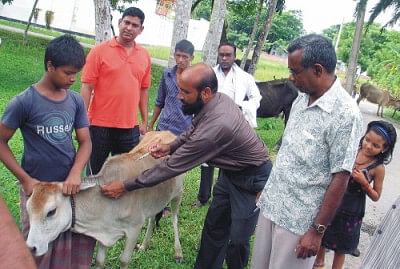Containing anthrax outbreak : Some suggestions

Inoculating domestic cattle against anthrax.
AS a Bangladeshi-American and a microbiologist, I am following the recent anthrax outbreak in Bangladesh with a concern. To my knowledge, this is the largest outbreak of human anthrax in the world since 1978-1980 anthrax epidemics in Zimbabwe (which involved 6,000 reported cases and 100 deaths). More importantly, there is no indication of a slowing down of the outbreak. Authorities in Bangladesh, according to the information published in some daily news papers, stated that the government has sufficient reserve of anthrax vaccine. However, it is not clear what the authorities have actually done to contain the outbreak. It was also stated in the news papers that the citizens should not be concerned about the outbreak since the disease is not dangerous and can be treated easily. And stated that even village doctors (lacking modern medical training) and pharmacists are able to treat the disease.
Such public information in the absence of any effort of an assessment or quarantine, a vaccination campaign or prophylactic treatment of the potentially exposed citizens or even a substantial effort to educate the public is troublesome. Government is allegedly investigating the sources of unnecessary propaganda on anthrax outbreak. The government should be careful and not suppress honest approach of public education and public awareness.
It is true that anthrax is not communicable (the disease does NOT transmit from person to person) and some forms of the disease (i.e. skin or cutaneous anthrax), if diagnosed early, can be treated easily using antibiotics such as penicillin, doxycycline and ciprofloxacin. However, Bangladesh is a country where antibiotics use is not regulated and many pathogenic bacteria have become resistant to multiple antibiotics. If anthrax is detected late, particularly gastrointestinal and pulmonary anthrax, the disease can be fatal. Late stage anthrax may involve massive ulcer, edema, bleeding, high fever, shock and hemodynamic instability leading to death. A high level of supportive therapy, in addition to antibiotics, would be necessary to treat such conditions.
Finally, if anthrax toxins are present in the body of the infected subject, hyperimmune serum (i.e. antitoxin) would be necessary in addition. Death rate among patients with untreated anthrax approaches 100%. Death rate among treated patients is 1-76% depending on the type of anthrax and the time of diagnosis. Thus, anthrax is not necessarily a simple and easily treatable disease. While public fear should be suppressed, the public should get accurate information.
Public education is of utmost importance in containing a disease outbreak. Citizens should know how anthrax is transmitted. Anthrax bacteria do not transmit from person to person. The bacterium grows in massive numbers in the infected tissues of animals. The bacteria may come out of the infected animal through blood and other body fluids. Once the bacterium is out of the body, each bacterium quickly turns into an endospore. The endospores are an inactive or dormant form of the bacterium that can be present in the excretions, fur, hide and meat of the infected animal. Milk is not a significant source of endospores. Endospores are also present in the soil where sick animals dwelt. Removing the endospores from contaminated soil is nearly impossible. The endospores are extremely stable and can be viable in the open environment for decades or even centuries. Desiccation, cooking and boiling (for several days) would not inactivate endospores. Endospores can be inactivated by gamma irradiation, autoclaving and certain chemicals such as formalin.
Anthrax infection occurs when endospores enter human tissues. Estimates vary, but it is generally held that as low as 10 endospores may initiate an infection. Infections initiated with a large number of endospores (>10,000) could be fatal. Endospores entering through skin wounds and eyes cause cutaneous anthrax indicated by dark coloured wounds. The disease may progress to edema, swelling of lymph nodes and high fever. The name of the disease (anthrax) originated from the coal (anthracite)- coloured skin ulcers. If the endospores enter wounds of the oral or intestinal tissues, gastrointestinal anthrax ensues. Gastrointestinal anthrax involves sore throat, ulcer in mouth and esophagus, fever, nausea and bloody diarrhoea. Endospores may stay dormant in human body especially in the nose for months. Once the endospore enters lung, it may cause dry cough, fever, vomiting, sepsis and meningitis (surprisingly, pneumonia is uncommon).
There is no specific symptom of the disease other than the dark ulcers of the skin. The bacteria grow rapidly in the body of the patient. Bacteria can be easily isolated from the infection sites and blood of the patient. Bacteria oozing out of the patient body may form endospores and then transmit to another person. Animals and humans died of anthrax must be sealed and buried under soil as fast as possible. Slaughtering sick animals, processing and handling meat and hide of the animal and cooking and eating meat of the sick animals may cause rapid disease transmission. Note that cooking does not inactivate the endospores. Since meat (arguably even cooked meat) can be a source of infection, everyone who deals with or eats animal meat is potentially vulnerable to infection when an active anthrax epidemic among cattle is ongoing. Thus an effective public health intervention is necessary for containing an anthrax epidemic.
Anthrax normally affects wild and domestic grass eating animals including cows, goats, sheep and deer. Meat-eating animals and carrion-eating birds may also get infected upon eating carcass of an infected animal. A complete and routine vaccination of cattle has virtually eliminated anthrax from the developed countries. Almost all recent natural anthrax cases among humans in the developed countries originated from animal fur, woollen garments and incompletely processed leather goods imported from developing countries. Bangladesh raises and imports a large number of cattle and she also has a large number of wild herbivores. It will be nearly impossible to vaccinate all herbivores until the country starts manufacturing anthrax vaccine domestically.
Beef and goat meat have become the major source of protein in Bangladesh partially because of increased price and low supply of pulses and fish. Fear of bird flu has also contributed to more dependence on cattle meat. The recent outbreak has plummeted animal meat consumption. It has obviously reduced overall animal protein consumption and contributed to financial losses for farmers, cattle traders, butchers, meat traders and restaurateurs. Each of these parties needs a coordinated and comprehensive effort to contain the present outbreak and prevent future outbreaks of anthrax. The following measures could be helpful to achieve the goals:
-Quarantine all imported cattle.
-Test every imported cattle for anthrax before allowing the animals to enter the country.
-Test every cattle before it can be slaughtered.
-Restrict cattle slaughter in the permit-holding slaughterhouses.
-Isolate infected animals and treat the animals only if feasible. Many countries have laws that prohibit medical treatment of animals infected with anthrax because it may undermine animal vaccination. Ideally, confirmed infected animals are killed by lethal injection. Intravenous injection of ~10 ml of saturated solution (3.5 moles/litre) of potassium chloride would kill a large bull instantly without any suffering.
-Cover the dead animal with a plastic film if possible (before touching) and bury it under six feet of soil (incineration is ideal but not be practical in Bangladesh).
-Dispose of soil and water contaminated with exudates of the infected cattle in the same pit. Hay and other contaminated animal fodder should be burned.
-Enforce meat inspection uniformly.
-Restrict meat sale by licensed meat vendors only.
The above steps are standard practices in the developed countries. In Bangladesh, those should be implemented at least in the affected areas. Such efforts would restore public confidence and actually bring the crisis to an end.
Each of the above steps would add more government intervention of almost completely unregulated public life in Bangladesh. The regulations may potentially add more sufferings to the parties involved. The government should strictly monitor the operations so that the veterinarians, pathologists, inspectors and other government employees do not take kickbacks and other advantages.
An important part of managing the outbreak is ensuring a proper treatment of the infected human subjects. The subjects should be treated by an appropriately trained physician who would test drug-susceptibility of the causative bacterium and enforce appropriate use of effective antibiotics. Improper use of antibiotics may cause antibiotic resistance in the bacterium. Bangladesh is infamous for unregulated antibiotic use. Shortage of trained physician, laxity in regulating pharmacies are some of the major causes of such abuse. While solving the above problems needs a long-term plan and significant investment, at this point the government should send a special medical team to the affected areas and supply medication free of cost. The team should test antibiotic susceptibility of the bacterium and publish a guideline for treating various types of anthrax. Finally, the government should test every person who has visited the affected areas before allowing them to travel foreign countries. If a traveller from Bangladesh is diagnosed with anthrax in a foreign country, it will be a huge blunder.
Highly useful information on anthrax can be found in the following internet resources (http://www.who.int /csr/resources/pulications/anthrax/whoemczdi986text.pdf and http://emergency.cdc .gov/agent/anthrax/).

 For all latest news, follow The Daily Star's Google News channel.
For all latest news, follow The Daily Star's Google News channel. 



Comments